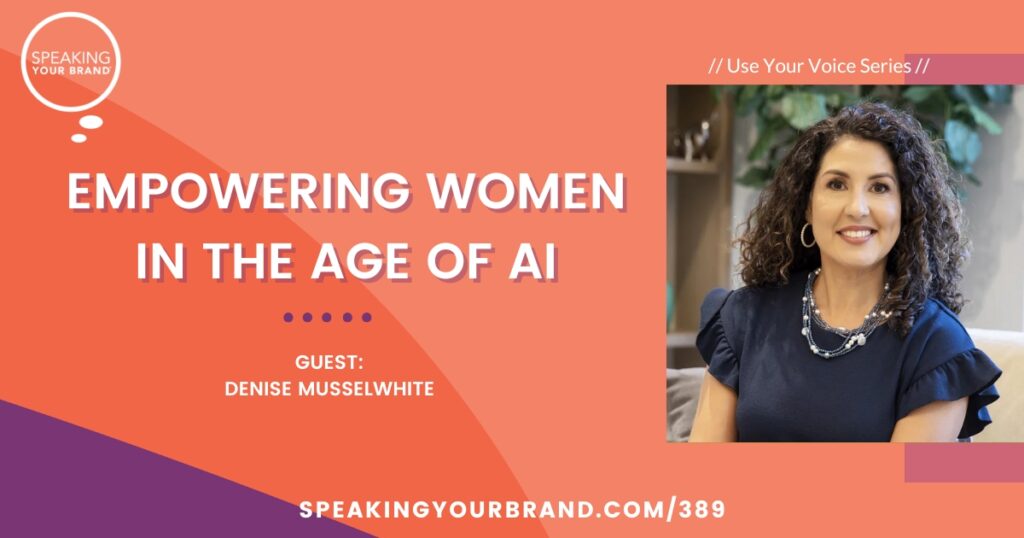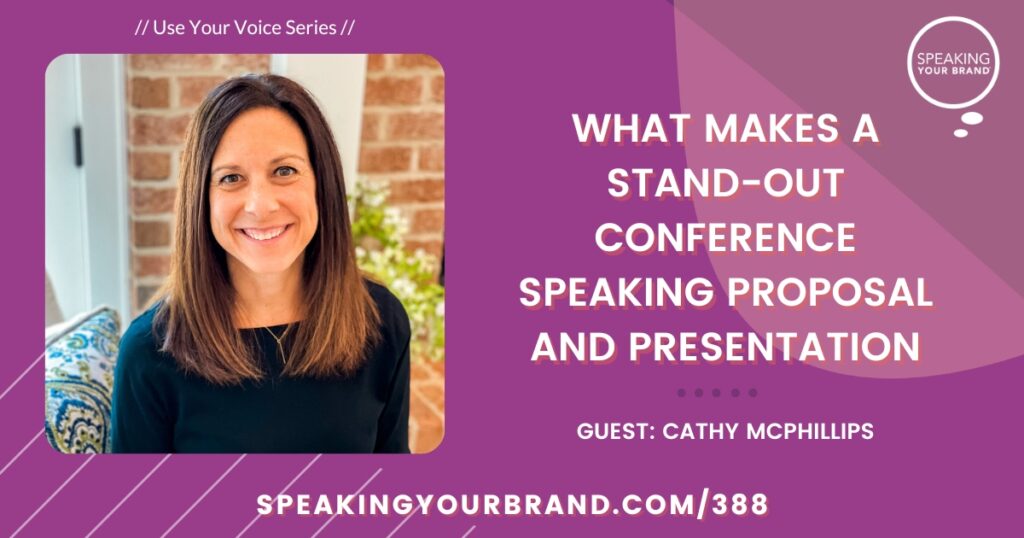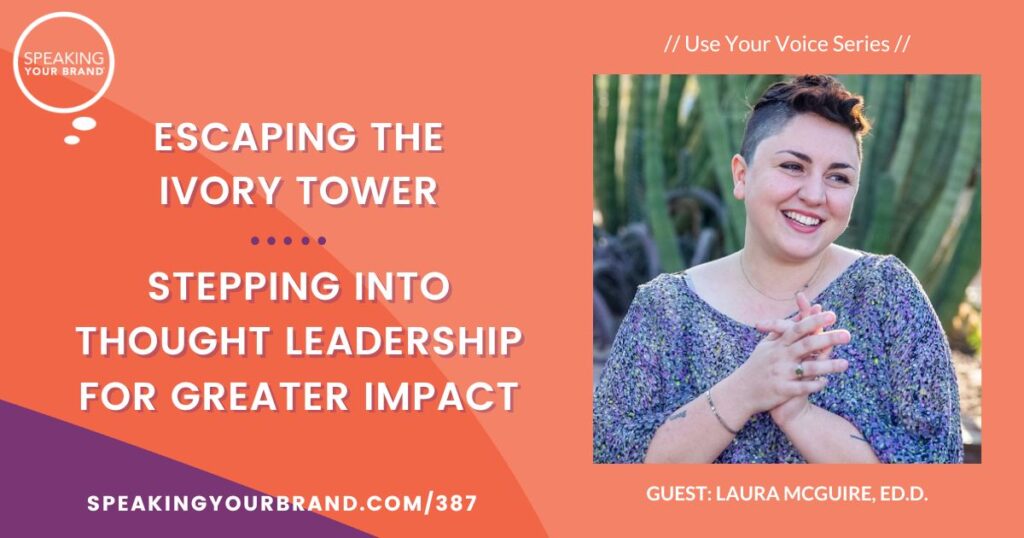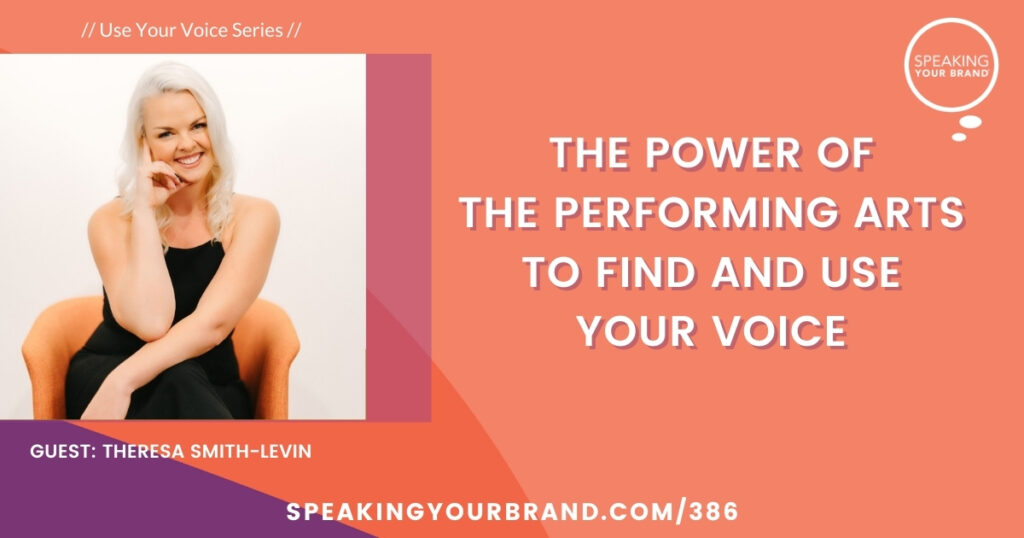Trends in Public Speaking and Thought Leadership for 2022 with Carol Cox: Podcast Ep. 258
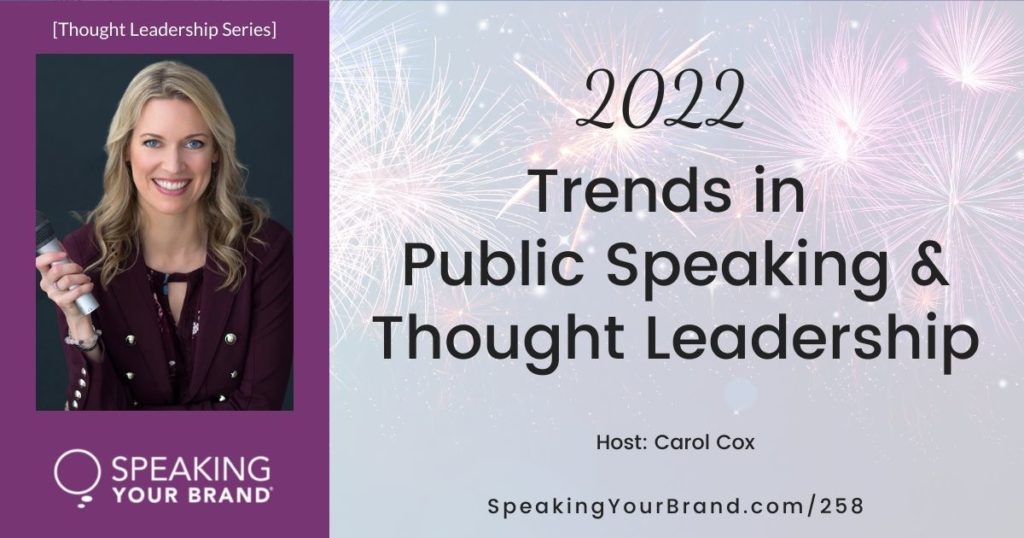
Subscribe to the podcast!
Happy New Year! This is the 4th year in a row I’ve done a trends episode for the start of the year.
What I mean by trends are not fads or cliches or gimmicks.
Trends are like currents or waves of energy that move through our society and affect everything from business and politics and the economy to popular culture and media
How do these trends impact our public speaking and thought leadership?
As speakers and leaders, our talks and messages have more of an impact if our audiences can see the bigger picture of what’s affecting them and the world around them.
In this episode, you’ll learn 3 trends (and action steps for each) related to format, audience, and content that you can apply to your speaking and thought leadership, as well as to your business and visibility strategy in general.
About Us: The Speaking Your Brand podcast is hosted by Carol Cox. At Speaking Your Brand, we help women entrepreneurs and professionals clarify their brand message and story, create their signature talks, and develop their thought leadership platforms. Our mission is to get more women in positions of influence and power because it’s through women’s stories and visibility that we challenge the status quo and change existing systems. Check out our coaching programs at https://www.speakingyourbrand.com.
Links:
Show notes at https://www.speakingyourbrand.com/258/
Join our Thought Leader Academy: https://www.speakingyourbrand.com/academy/
Connect with me on LinkedIn: https://www.linkedin.com/in/carolcox
Related Podcast Episodes:
- Episode 251: What Makes Public Speaking Unique as a Medium with Carol Cox and Diane Diaz
- Episode 241: The Expert Trap: What Holds Women Back from Thought Leadership with Carol Cox
258-SYB-Trends-for-2022.mp3: Audio automatically transcribed by Sonix
258-SYB-Trends-for-2022.mp3: this mp3 audio file was automatically transcribed by Sonix with the best speech-to-text algorithms. This transcript may contain errors.
Carol Cox:
What trends should you be paying attention to in public speaking and thought leadership here, three of mine on this episode of the Speaking Your Brand podcast. More and more women are making an impact by starting businesses running for office and speaking up for what matters. With my background as a TV political analyst, entrepreneur and speaker, I interview a coach purpose driven women to shape their brands, grow their companies and become recognized as influencers in their field. This is Speaking Your Brand, your place to learn how to persuasively communicate your message to your audience. Welcome to the Speaking Your Brand podcast. I’m your host, Carol Cox, and Happy New Year! I don’t know about you, but I’m really hoping 2020 shapes up to be better than 2020 and even 2020 one was now. This is the fourth year I’ve done a trends episode for the start of the year. I started this in twenty nineteen, then in twenty twenty twenty twenty one and now I can’t believe we’re on twenty twenty two. And what I mean by trends are not fads or gimmicks or cliches not like, Oh, what’s the latest fad that people are doing on a social media channel? Rather, trends are like currents or waves of energy that move through our society and affect everything from business and the economy and politics to popular culture and media. Now I’m a student of history. My undergraduate and graduate degrees are in history with the focus on women’s history and gender studies, so I very much love looking at the past to see how people lived, how people thought, how people created the world that we live in now, and as much of a student of history as I am.
Carol Cox:
I also recognize the power that understanding history has to understand our present and to see what the future could possibly look like. This is why I have such a fun time doing these trends. Episode last year’s trends at the beginning of Twenty Twenty One. We’re very much influenced by the impact of the pandemic, obviously on the conferences and events that ended up getting postponed and canceled, as well as the Movement for Racial Justice that took off in the summer of 2020 after the murder of George Floyd. So here’s a recap of the twenty twenty one trends. When I do these three trends, I put them into three categories format, audience and content specifically related around public speaking and thought leadership. So the three trends for last year was around format. So virtual is here to stay even post Covid, because obviously everything went virtual in 2020. But then looking into 2021, I said, you know, virtual is here to stay. Audience trend was that people wanted to be more involved. They wanted participatory events, ways that they could get involved, activism making their voice heard. And it’s very much came out of that movement for racial justice that that took off again in the summer of 2020 and then the third category trend around content.
Carol Cox:
So the desire on the part of your audience, whether your audience is on social media or listening to you on Zoom or on a webinar or on a podcast or in public speaking, is this desire for authenticity and transparency? And here is Speaking Your Brand. We very much followed these trends with our Brave Bold Beyond live virtual summit. The second one that we did in April of twenty twenty one, it was definitely virtual. It was very much participatory and our speakers were incredibly authentic and transparent with their personal stories and the big ideas that came out of that. In this episode today, I’m going to talk about three trends for twenty twenty two in action steps that you can take that you can apply to your speaking and thought leadership. These are big picture concepts that apply not only to your presentations, but to your business and visibility strategy as well. If you are a returning listener to the Speaking Your Brand podcast, thank you so much for joining me for another year. And if you’re new, welcome, I am so glad to have you hear us Speaking Your Brand. We help women entrepreneurs and professionals clarify their brand message and story, create their signature talks and develop their thought leadership platforms. We know that it’s through women’s stories and voices through women’s visibility, representation, influence and power that we challenge the status quo and change existing systems to benefit more people.
Carol Cox:
The act of public speaking and having a public voice is so critical for women’s leadership and to advance gender equality. To learn more about how we can help you create your signature talk and your thought leadership message and to put yourself out there in a bigger way, I invite you to check out our Thought Leader Academy. Enrollment is open. You can submit your application today by going to Speaking Your Brand academy. Again, that’s Speaking Your Brand academy. Now let’s get on with the show. Let’s get into these three trends for twenty twenty two. The first category is around format. So what is format going to look like regarding public speaking? Now, a year ago, I had said that virtual is here to stay and very much that continue to be the case for twenty twenty two. I’m going to call it hybrid speaking, so hybrid speaking means that there’s going to be a lot of events and conferences that have an in-person component, but then also recognize that they need to have a really robust virtual component as well. Not. Just kind of like an afterthought, I’m going to stick a camera in the back of the room and record or attempt to live stream a speaker, but rather really making the virtual experience as good as possible to compete with the in-person experience. I know there are so many of us who are eager to go back to conferences and events as speakers and as attendees.
Carol Cox:
We love meeting new people. We love speaking and so I am very excited for that to happen as well. I have two in-person speaking engagements at the end of January of this month, so I’m excited for those as well. But I think a lot of conferences and events recognize that with how much uncertainty there is still around COVID, that having the virtual options is going to be a must. The pros of having a virtual option having these hybrid events is that it’s a way for these events and conferences to expand their audience. There are so many people who traditionally were not able to travel to go to conferences either because of the cost, because of child care or other type of caregiving responsibilities, because maybe they had some disabilities that made it difficult for them to travel or difficult for them to attend in person. Obviously, we have the impact of climate change and a lot of air travel that that can contribute to. So I think that there’s a lot of events and conferences that recognize the pool that virtual has. There’s also so much convenience and flexibility for attendees. Having hybrid events both in-person and virtual, also allows a lot of conferences to have more speakers and to improve the diversity of both their speakers and their attendees. Now, as I said a year ago, this is not a pass for conferences to give their most coveted in-person speaking slots to the same old group that they always get, but rather making sure that they’re pulling in diverse speakers and new speakers into both their in-person and their virtual lineups.
Carol Cox:
Now, the table beyond live virtual summits that we hosted in Twenty Twenty and Twenty Twenty One showed me that online events can be just as good and engaging as in-person ones. In February of twenty twenty one, I was the emcee for an online event called Lou-Ann Live. Lujan Niagara is the host of a podcast called A Well Designed Business. She is fabulous and she’s been putting on an in-person event. But obviously because of COVID, it went one hundred percent online now. Lou Ann and I have worked together on her keynotes. I think for the past five years we would work together. And when she went 100 percent virtual with this event last year, it was incredible. With so well-produced, it was fun, it was interactive and it showed the power of virtual events. Now for going into twenty twenty two and as we even look beyond twenty twenty two, the ability to speak to audiences who are both in-person and virtual at the same time is a skill that as speakers, we’re going to have to develop speaking to just in-person audiences or speaking just to virtual audiences such as on Zoom or on a webinar. They are two different skill sets and you can get good at one versus the other.
Carol Cox:
But having hybrid events where say you are a speaker in person, so you’re in a room, there’s an audience in front of you, maybe a smaller audience, and there traditionally would have been, but there’s still an in-person audience there. And you also know there’s a live audience and maybe a large live audience watching you and listening to you who are online. You’re going to have to go be able to go back and forth and flow between engaging the in-person audience and engaging the audience who’s watching virtually. This reminds me of a recent LinkedIn Live that I did with a client of mine, Kristen Oakley, who’s a professional speaker. And in that LinkedIn Live, we talked about the gender speaking gap. I’ll include a link in the show notes to that LinkedIn Live, and you can find the show notes by going to Speaking Your Brand. Two five eight. So it’s episode number, Speaking Your Brand to fifty eight. And Kristen talked about some of the events that she did in 2021, where it was these hybrid, where she was in person in a room with a small audience. But most of the audience was virtual, and she had to make sure that that virtual audience was getting engaged. And she had this really fun idea that she and the event organizer came up with for this one event where they sent these emoji cards like kind of like paddles that the audience on Zoom could hold up that had different emojis like a, you know, a happy face.
Carol Cox:
You know, the laughing, crying face, maybe like an angry face, what have you? And so then different parts of her talk, you know, she would ask certain questions and then ask for audience reactions, and they would hold up those emoji cards. So I thought that was a great way to kind of give that little bit of an in-person experience to the virtual audience. So thinking about this format of hybrid events, hybrid speaking, here’s what you can do is definitely practice the ability to engage an audience both in-person and virtually at the same time, apply to speak at more conferences. Events and conferences are going to need speakers like they always do. And if you have the skill set, that’s going to be such a bonus for you. You can also host your own event like we did for our baby on Live Virtual Summit. It really does position you as a thought leader to host your own event. And you can host yours virtually. You can host it in person and or having a hybrid version of it. We’re hosting a private client retreat workshop in March of twenty twenty two in person in Orlando. So clients who’ve worked with this in our Thought Leader Academy or have worked with us one on one in VIP days are eligible to attend. We’re going to be providing a full day of training on in-person speaking with also recognizing this need to practice the skill of in-person and virtual at the same time.
Carol Cox:
And then the second day we’re going to provide opportunities for the women in attendance to practice. Plus are going to get professional videography of them speaking that they’ll be able to use in their speaking real. If you are a client who has worked with us in the past and you’re interested in this client retreat that we’re doing. Email me at Carol Cox Speaking Your Brand. And if you’re not a past client, but you would like to attend this retreat, you can enroll in our Thought Leader Academy or work with us in a VIP day, and then you would be eligible. You can also email me. Carole Cox Speaking Your Brand and we’ll chat about that. So that was the first trend around format, which is hybrid events, hybrid speaking. The second trend is around the audience. So what is your audience looking for? Really, what I feel like after two years of, you know, not being able to see that many people in person not being able to go to events is that we have this desire for what’s called collective effervescence, collective effervescence. Is this feeling the sense that we get as humans when we’re together in a group and we’re doing something in common so it could be movement, dance, singing, call and response, even laughter? When you’re doing that with a group of people, especially in person, you get this sense of like this that’s high almost from not just because you’re laughing and singing and dancing, but because you’re doing it with other people.
Carol Cox:
It provides this level of connection with the audience, and it’s just a just fun. I think like we have this deficit of fun for the past two years and, you know, with good reason, and I feel like I know I’m so hungry for just having a place to kind of have fun and to connect with others. So as a speaker, think about, especially for in-person events that you’re doing. How can you incorporate movement, dance, singing, laughter or call and response into your own presentations? The third trend is the category of content. And so last year, I talked about the desire that our audiences have for authenticity and transparency in the content that we’re sharing with them, and that will remain the case going forward. Right now, I want to point out what your audience really is hungry for is big ideas. They want to understand the world, they want to understand themselves, they want to understand how they interact with the world. They want to imagine what’s possible. Your audience is chock full of tips and tactics and techniques and secrets and like, do this and do that. And here are the five things to do. And here are the 10 things to do. And it just gets so like we just get so overwhelmed with all of those tips and tactics.
Carol Cox:
So think about for your own presentations. How can you take your audience on a journey to imagine what’s possible? And this is what I call getting out of the expert trap. I did an entire episode on this back in July of Twenty Twenty One Episode Forty one. I’ll include a link in the show notes all about the expert trap and how, as women, especially, we tend to get stuck in the expert trap. It’s because we are very highly regarded and valued for the skills that we have the credentials, the degrees, the information. And definitely, you should be an expert. Your clients need you to be an expert in what you do for them, but for your public speaking and your thought leadership. I want you to think bigger than just around sharing whatever your area of expertise is. Thought leadership really is the next stage in your evolution as an entrepreneur and as a speaker, and it’s a shift in identity from having the answers for your audience to asking questions of your audience. And why this is so important for women is because as women, we think we have to be an expert and everything that means we oftentimes don’t seek leadership positions because we don’t think we’re expert enough. We don’t pitch ourselves for bigger opportunities because we don’t think we’re expert enough. Just a couple of days ago, as I’m recording this episode, there was a Twitter thread about a women in science who have contributed so much to COVID and our understanding of COVID over the past two years.
Carol Cox:
And this was precipitated because there was an article in the Times of London newspaper that profiled data scientist and guess what? They were all men that this article profiled not one woman, not one person of color. And so there, of course, a bunch of people on Twitter, you know, talking and tagging all of the women scientists who have contributed to. To understanding COVID, and then there was this one reporter from the Financial Times who also made a thread of all of the women that he knows that he has followed, who has to have been instrumental and understanding of it. And then he said towards the end of the thread where he tagged all these different women, he said as a reporter, I reach out often to get quotes for and to get people to say things for the articles that I need to write. He’s like the men that I reach out to have no problem getting back to me right away and giving me quotes. He says the women that I reach out to are much more hesitant to give me quotes, and that says so much about us as women being stuck in this expert trap that we never think we’re expert enough. And here’s the thing you don’t have to be the world’s foremost expert to give a quote to the media.
Carol Cox:
They don’t expect you to be the world’s foremost expert on that. They just need a quote. One of the things that we do in our Thought Leader Academy is that we have a live workshop where we talk about pitching the local media to help you pitch your local TV stations. And so many times the women who come through our Thought Leader Academy think that they’re not eligible or they’re not expert enough, they’re not credentialed enough to pitch their local media, and they and you and them absolutely are. So I want you to think about getting yourself out of this expert trap and sharing more of your ideas and your personal stories and your opinions. Because when you start asking these bigger, deeper questions of yourself, you also start asking them of your audience. And that’s really so incredibly helpful to position yourself as a thought leader and to have the bigger impact for your audience. I believe that women in particular face the expert trap because we need to be seen as more competent than men to get the same professional opportunities. We’re often penalized for having opinions and for speaking up, and this is especially the case when we see those comments on social media. So I understand the hesitancy that women have to give these quotes, but just don’t read the comments like my guest, Dr. Christina Madison and I talked about on that episode we did a few weeks ago all about TV.
Carol Cox:
And so it just no that put yourself out there, have that support system, have that community around you and don’t read the comments. Now I hear from so many women who come to us because they recognized or stuck in expert mode and they’re ready to do more. They are ready to get clarity around their bigger message and put all that together in a talk that feels like them. And this is what we help you to do in our Thought Leader Academy. One of the women who’s going through our academy right now told me back when she joined that she was done with just being a breakout session speaker at conferences. She wants to elevate her content, to tighten her message, to go bigger and bolder with her idea, to help her audiences imagine more and to have a strategy and a plan for making this happen. This is exactly what we help you to do in our Thought Leader Academy. We work together in our five step process to help you get clear on your compelling idea and your thought leadership message, and to uncover your core story to craft your signature talk, to create your visibility plan to identify the best monetization methods for you regarding speaking and to help you learn how to deliver your talk for maximum impact and income. And what we hear from women who’ve gone through the academy is that it not only gave them these tangible outcomes, but confidence in themselves and a community of women who share the same desires.
Carol Cox:
The first step is to submit your application will then follow up with the Zoom call to talk about your goals and to make sure that the Thought Leader Academy is the right fit for you. You can get all the details and submit your application by going to Speaking Your Brand academy. Again, that’s Speaking Your Brand academy. To recap, the three trends for 2020 to the first around format is that hybrid conferences and events, we’re going to be seeing more of them, and hybrid speaking is a skill that you should definitely practice. The second one around audience is the desire for collective effervescence. So how can you put movement, dance, singing, music, laughter and call and response into your presentations? And the third trend, or is around content, is time to get out of expert mode and to really put your thought leadership out there. If you enjoyed this episode, I invite you to share it with a friend or a colleague. You can text the episode right from the share button in your podcast app. We’re going to continue to talk about thought leadership in the upcoming episodes, including generating revenue from your speaking and thought leadership and how to connect your business to your thought leadership. This is a question that I get from a lot of women. Until next time, thanks for listening.
Sonix is the world’s most advanced automated transcription, translation, and subtitling platform. Fast, accurate, and affordable.
Automatically convert your mp3 files to text (txt file), Microsoft Word (docx file), and SubRip Subtitle (srt file) in minutes.
Sonix has many features that you’d love including collaboration tools, transcribe multiple languages, advanced search, automated transcription, and easily transcribe your Zoom meetings. Try Sonix for free today.




